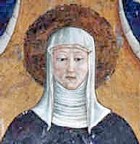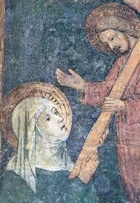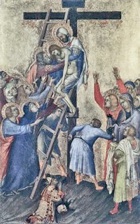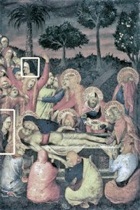


Detail of fresco (14th century) in the nunnery of
Santa Chiara, Montefalco, which Benozzo Gozzoli restored in 1452
An entry in the Roman Martyrology under 17th August reads: “At Montefalco in Umbria, St Clare, a nun of the Order of Hermits of St. Augustine, virgin. In her flesh were renewed the mysteries of the Lord's passion, which the faithful honour with great devotion. Pope Leo XIII solemnly inscribed her in the list of the holy virgins.”.
St Clare was born in 1268. Her much older sister, Joanna formed an eremitical community of women at what is now Sant’ Illuminata, Montefalco in ca. 1270 and St Clare joined her in 1274, when she was only six years old. In 1281, Joanna, Clare and some of their sisters moved to what became the convent of Santa Croce, Montefalco. The new community had to overcome the opposition of Franciscan friars and the local people, who objected that the town could not support another mendicant community. However, they managed to survive and, in 1290, secured the protection of Bishop Gerardo Pigolotti of Spoleto, who placed the nuns under the Rule of St Augustine.
When Joanna died 1291, Clare succeeded her as the abbess of the community. She manifested profound devotion to the passion of Christ, and was a renowned mystic. In 1303, she was finally able to build a church for the sisters and their small congregation. St Clare had prophesied the promotion of Bishop Nicolò Albert da Prato of Spoleto to the rank of cardinal: when he was so-consecrated in December 1303, he sent a diploma that authorised the laying of the foundation stone of the new Oratorio di SS Croce e Caterina (later incorporated into the church of Santa Chiara, Montefalco).
When Bentivenga da Gubbio, a Franciscan who had heretical views, tried to find converts among the nuns of Umbria in 1307, he made the mistake of trying to convert St Clare. She appealed to Cardinal Napoleone Orsini (who was legate for Umbria, Spoleto, and the March of Ancona in 1306-9). He arranged for his chaplain, Ubertino da Casale to mount a “sting” operation that produced the necessary evidence for the Inquisition, and Bentivenga was imprisoned for life.

When St Clare died in 1308, the nuns opened her heart in order to preserve it and found there the marks of the passion. Bishop Pietro Paolo Trinci of Spoleto sent his vicar, Berengar of Saint- Affrique, who was apparently "burning with indignation" suspecting that the nuns of the convent had planted the symbols. He appointed a panel of physicians, jurists, and theologians to investigate and it "ruled out the possibility of fabrication or artifice". Saint Clare was buried under the high altar of the oratory and her heart is displayed separately for veneration.
Cardinal Giacomo Colonna and Napoleone Orsini arrived from Rome and initiated the process of canonisation under the direction of Berengar of Saint- Affrique. Berengar of Saint- Affrique submitted the findings of the process to the Curia in Avignon in 1315. In 1318, witnesses were formally interviewed in San Francesco and their depositions were submitted to a panel of three cardinals: Napoleone Orsini, Nicolò Albert da Prato and the Franciscan Vital du Four. Their deliberations culminated in the “Relatio Trium Cardinalium”, which Cardinal Napoleone Orsini wrote in 1328-32. However, the process was suspended in 1333, revived and again suspended in the 18th century and not completed until 1881.
Relics of St Clare
The relics of St Clare were moved to the new church of Santa Chiara da Montefalco in 1430:
-
✴The body of St Clare is preserved in the silver urn under the altar, which was delivered by the Jesuits in 1612 on behalf of an anonymous donor.
-
✴Other relics are preserved behind two grated niches to the sides, which were opened in 1718 to reveal:
-
•a pectoral cross that Cardinal Giacomo Colonna had given to St Clare;
-
•a silver bust containing her heart;
-
•a silver cross-reliquary with the symbols of the Passion that was discovered in her heart; and
-
•the three stones found in her gall bladder.
Orsini Polyptych (ca. 1340)
This polyptych was a portable, devotional work made up of four double-sided panels that were hinged like a concertina. Two of the panels were signed by Simone Martini, but no related documents survive.
-
✴When the polyptych was closed, the two visible surfaces displayed the Orsini arms.
-
✴When it was partly open, the visible scenes depicted the figures of the Annunciation (now in the Koninklijk Museum voor Schone Kunsten, Antwerp);
-
✴When it was fully open, it depicted four scenes from the Passion of Christ:
-
•the way to Calvary (now in the Musée du Louvre, Paris);
-
•the Crucifixion (now also in Antwerp);
-
•the deposition of Christ from the cross (now also in Antwerp); and
-
•the entombment of Christ (now in the Staatliche Museen, Berlin).
Joel Brink (see the reference below) has pointed to a number of factors that suggest that the member of the Orsini family who commissioned this polyptych was Cardinal Napoleone Orsini.


Fresco of St Clare (1452)
A document in the archives of Santa Chiara records that Benozzo Gozzoli “made new again” an image of St Clare. Fra Antonio da Montefalco, the Vicar Provincial of the Observant Franciscans of Umbria, had translated the legend of St Clare into Italian, and was devoted to her cult: he may therefore have commissioned this restoration of the fresco (which is in what is now an an attic in the convent that cannot be visited). The fresco (a detail of which is illustrated above) depicts the standing saint holding her own heart, in which Christ had implanted the cross.
Read more:
J. Brink, “Cardinal Napoleone Orsini and Chiara della Croce”, Zeitschrift fűr Kunstgeschichte, 46 (1983) 419-24
Return to Saints of Montefalco.

